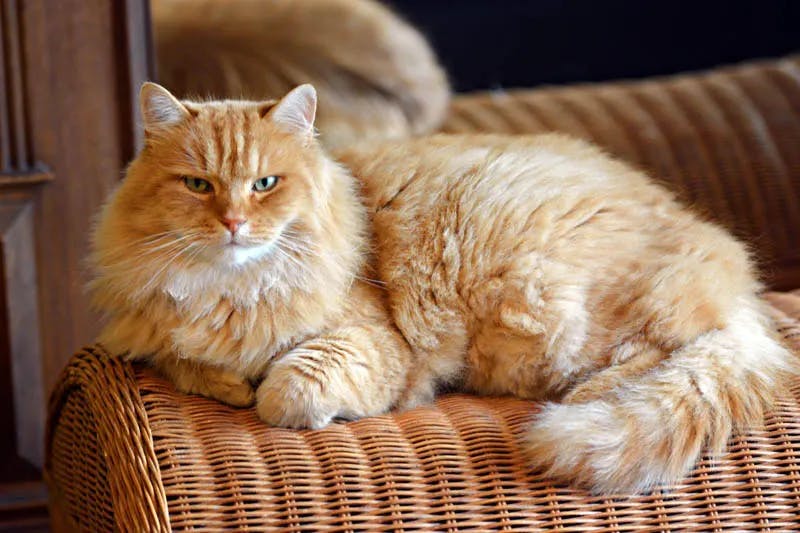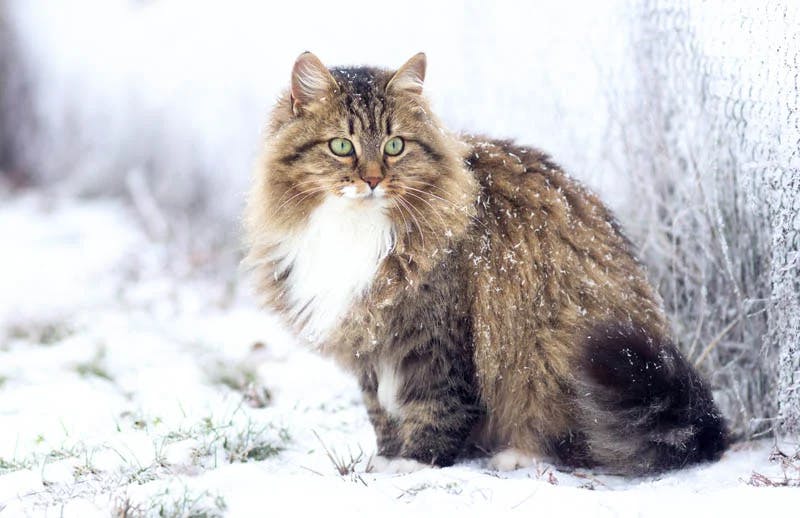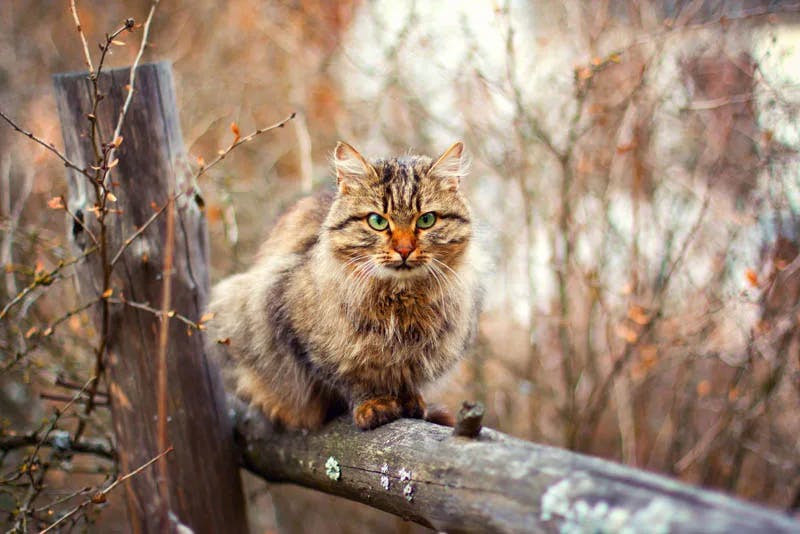Siberian Cat
A domestic cat that has existed in Russia for centuries
Siberian Cat
Jon Crimes - Last Updated on December 18th, 2021
What you Need to Know about the Siberian Cat
This Siberian cat is fairly large with a robust-looking build. They have existed in Russia for many centuries. Many modern-day long-haired cats can trace their ancestry back to this breed. Its official full name is the Siberian Forest Cat and it's regarded as the national cat of Siberia.
They share many similarities with the Norwegian Forest Cat. This includes a coat that makes them look like they belong in the wild. Siberians are natural hunters and will be great if you're planning on dealing with a rodent problem!
They are also great house pets and have a friendly, affectionate nature.

Appearance Matters. What does a Siberian Cat look like?
The Siberian Forest cat size makes it one of the largest domestic cat breeds. The male Siberian cat weight can be as much as 17 pounds, with females being smaller.
They have a thick, long coat that has evolved so they can cope with harsh Siberian climates. This coat includes a tight undercoat and a full rough around their neck. Natural oils complete the winter beating, water-resistant properties of their fur.
The Siberian has a wedge-shaped head, medium-sized ears, and 'expressive' eyes.
It can look as though they're trying to work something out, or they're looking 'guilty'!
Giants: Siberian vs. Maine Coon and Norwegian Forest Cat
The Siberian is a big cat, but what about a Siberian cat size comparison with some of the other big cats? Out of the Siberian, Maine Coon, and the Norwegian Forest cat, The Main Coon is the bigger breed.
Compared to the 17 lbs for a male Siberian, the Maine Coon can weigh in as much as 26 lbs. The Norwegian also has the Siberian beat, slightly. With males of the breed weighing up to 20 lbs.
Siberian Cat Colors
The breed has many color varieties and doesn't have any distinct or unique fur patterns. Common variations include:
- Solid
- Tabby
- Smoke
- Point
- Bi-color

It's all Personal. The Siberian Cat Personality
The Siberian cat personality is one of affection and playfulness. They are happy sitting in your lap and love to be brushed and handled. They also have a fascination with water!
Just like Bengal cats, they can be found investigating anything to do with the wet stuff. This can include dropping toys in water dishes or acting curiously around the bathtub when it drains!
The Siberian cat temperament is very dog-like. These are loyal cats who will come to greet you with enthusiasm. They will also do the same with other cats, some dogs, and even strangers.
With their unique ability for problem-solving, Siberian cats certainly know how to get what they want. They have an unmissable amount of intelligence.
Although they have a large build, they can also be surprisingly agile. Expect your Siberian to enjoy jumping, even between tall 'inaccessible' furniture.
Want a cat that 'talks' back to you? You're in luck with the Siberian. These chatterboxes will communicate in soft mewing sounds. They'll do this when they find something of interest or want access to a closed door. They also make an unusual and distinctive chirping sound.
Can Siberian cats be indoor cats?
Siberian cats are totally suited to the outside and cold environments. They are also very happy as indoor cats and will make a very natural addition to the family.
Caring for your Siberian Cat
With their long, thick coats, the Siberian is surprisingly easy to groom. Their coat has three layers. These layers combine to make the fur nearly completely weatherproof and less likely to mat. Twice-weekly brushing is required to keep mats away and the coat in good condition.
They're not completely hypoallergenic but they're one of only a few cat breeds that nearly get there! Since being imported into the U.S.A, their hypoallergenic qualities have been talked about. The breed produces low levels of allergen. This makes them one of the best cats to consider if you suffer from allergies.
With regular brushing, daily shedding won't be a problem. But, there is something to be aware of! Siberian cats have a 'big shed' twice a year. This happens once in the Spring and then in the Fall. It's advisable to look out for this happening and be prepared to do a bit of extra grooming to compensate for it. Along with brushing, you should build some other activities into your grooming routine.
Check their eyes for natural discharge and wipe away with a soft damp cloth if required. Also, inspect their ears for any dirt on the outside of the ear. Clean if required.
They are natural jumpers and ever-adventurous. So also make sure to look at their nails regularly and trim if necessary.

The Health and Happiness of your Siberian Cat
Siberian cats are thought of as healthy and robust. But there are some genetic conditions that affect the breed.
These include:
- Persian kidney disease. This genetic disorder can lead to cysts forming in the cat's kidneys. If the condition progresses then this can lead to kidney failure. There is a test available to screen for this disease.
- Hypertrophic cardiomyopathy. This condition reduces the effectiveness of the cat's heart due to the thickening of the heart muscles. Symptoms can be vague or non-existent but might include difficulty breathing and lethargy.
Siberian cats are at their most happy when they have a companion. This can be a human company or with the addition of another cat.
You can expect your Siberian cat lifespan to be between 12 and 15 years.
Where Can I Find Siberian Cat Breeders?
These cats look like they belong in the wild, and their feral looks are not the only thing that is pointing to that. Finding a breeder for these kittens can be quite tricky.
You will definitely want to check out our list of Siberian cat breeders to find the best one for you. It gets updated regularly, and since this breed can be rare you will probably need to wait a bit longer for one to appear.
These cats can get quite expensive, with prices ranging from $1,200 to $4,000.
Feline History. Where does the Siberian Cat come from?
The origins of this breed are uncertain. But it is thought that these cats were first spread by Russian Emigrants. Whilst in Siberia and other parts of Russia, the cat developed into the breed we see today. Its appearance is a testament to its ability to survive those unforgiving conditions.
The cat has quite a deep history on the Asian continent and throughout Europe. There's even reference to the breed dating as far back as 1871 at one of the earliest cat shows in England. The Siberian cat is still new to the United States but is becoming increasingly popular.
A breeder from Louisiana, Elizabeth Terrell, is credited with introducing the Siberian to the U.S.A. With investment and help from the breeding community, the Siberian cat was established as a recognized breed in America.
